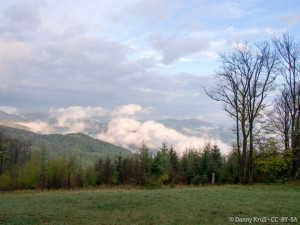Scientists evaluate a process that uses NanoSIMS and Raman microspectroscopy for in situ microbial studies.
The Science:
To investigate in situ function of uncultivated microbes, scientists evaluated a process for preparing soil samples for single-cell analysis methods.

Some of the soil samples used for the study were collected from the beech forest at the Klausen-Leopoldsdorf in Lower Austria. (Credit: Danny Krull via Flickr CC BY-SA.)
The Impact:
The process allows researchers to efficiently analyze microbial activities at the single-cell level in soil systems, which can help in investigations of how the uncultivated majority of microbes in soils influence the terrestrial carbon and nitrogen cycles.
Summary
A handful of soil contains a multitude of microbes, and characterizing each one and then understanding how they all interact with each other and influence global cycles are challenges researchers are trying to address. To help overcome these obstacles, the U.S. Department of Energy Joint Genome Institute (DOE JGI) launched the Emerging Technologies Opportunity Program (ETOP) in 2013. Through ETOP, collaborators develop new technologies to add value to the sequencing and analysis capabilities that DOE JGI already provides to its users for energy and environment applications.
The six ETOP proposals approved in 2013 spanned the development of new scalable DNA synthesis technologies to the latest approaches to high throughput sequencing and characterization of single microbial cells from complex environmental samples. From the latter proposal, a study published August 31, 2015 in FEMS Microbiology Ecology by the University of Vienna and DOE JGI researchers describes a pipeline to efficiently prepare cell extracts from soils for subsequent single-cell methods such as high-resolution secondary ion mass spectrometry (NanoSIMS) or Raman microspectroscopy. NanoSIMS has been used to study the in situ function of uncultured microbes in their native environments, while Raman microspectroscopy, which allows researchers to learn about the molecular composition of a sample, has been used to characterize soil structure or mineral content. Neither of these methods has been applied to the study of uncultivated microbes in soils.
“It was the aim of this study to develop a workflow for the efficient application of NanoSIMS and Raman microspectroscopy to soil microorganisms, and to assess the potential and limitations of stable isotope incubation experiments of soils in combination with these methods,” the team reported. They used soil samples from two Austrian locations: a beech forest and alpine meadows. After separating the cells from soil particles, the team incubated the cells with stable, isotope-labeled substrates before prepping them for NanoSIMS and Raman microspectroscopy analyses.
The team’s objective was to reduce the amount of soil particles in the samples for more efficient single-cell analyses. They found that they had a higher recovery rate for cells that had been initially fixed with formaldehyde compared to unfixed cells. The cell detachment method worked well for allowing the teams to visualize cells using both NanoSIMS and Raman microspectroscopy analyses. The work furthers previously reported studies from the same team where they had carried out proof-of-principle experiments.
The latest call for ETOP Letters of Intent concluded in August, with new projects slated to start in 2016.
Contact
Tanja Woyke
DOE Joint Genome Institute
[email protected]
Funding
- U.S. Department of Energy Office of Science
- Marie Curie International Incoming Fellowship
- Marie Curie Career Integration Grant
- Austrian Science Fund
Publication
Eichorst SA et al. Advancements in the application of NanoSIMS and Raman microspectroscopy to investigate the activity of microbial cells in soils. FEMS Microbiol Ecol. 2015 Aug 30. doi: 10.1093/femsec/fiv106. pii: fiv106. [Epub ahead of print]